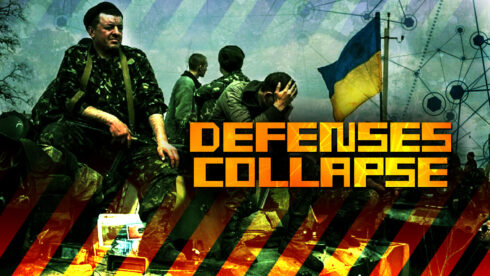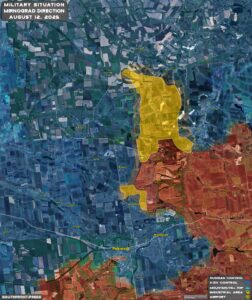In a significant development along the Donbass front, Russian assault units have achieved a substantial operational breakthrough east of Dobropolie (Dobropilya), making rapid advances into surrounding areas through depleted Ukrainian defense. This offensive push, which has seen Russian forces penetrate up to more than a dozen kilometers into previously held Ukrainian territory, represents one of the most substantial gains since the beginning of the Russian summer military campaign and threatens to destabilize Kyiv’s entire defensive system in the region.
The Ukrainian military is sounding the alarm. Local Ukrainian sources claimed Russian control of the strategically important village of Zolotoy Kolodez and assault on the stronghold of Rodinskoe.
The capture of Zolotoy Kolodez and subsequent push to the north carries profound operational consequences that extend far beyond the immediate battle area. Russian forces have now intersected the T0514 highway from Dobropolie to Kramatorsk, severing one of the most important supply routes in the Donbass. This development places several key Ukrainian strongholds in imminent jeopardy.
The Russian breakthrough follows a now well-established but increasingly refined tactical approach. Small, highly mobile reconnaissance and assault groups have been conducting intensive forward operations to identify weak points in Ukrainian defensive lines. These specialized units, typically consisting of 10-15 soldiers, infiltrate Ukrainian positions under cover of artillery and drone suppression, establishing footholds in tree lines, abandoned trenches, or buildings before calling in reinforcements.
This military approach has proven devastatingly effective against Ukraine’s overstretched defenses. Russian engineering units demonstrate remarkable efficiency in rapidly converting captured Ukrainian fortifications into strongpoints, often completing these transformations within hours of seizure. The speed of these operations has repeatedly outpaced Ukrainian commanders’ ability to organize effective counterresponses, creating a dangerous dynamic where each small Russian gain enables larger subsequent advances.
Russian drone strikes in Dobropolie:
The Kramatorsk-Slavyansk defensive complex, long considered the linchpin of Ukraine’s Donbass defenses, now faces potential envelopment from an unexpected direction. These heavily fortified positions were designed to withstand attacks from the east, but their western approaches contain only light field fortifications. Meanwhile, Russian reconnaissance elements probing toward the M30 highway near Novovodyane threaten to develop a new axis of advance that could ultimately jeopardize Pavlohrad, the critical transportation hub serving as the main supply conduit for all Ukrainian forces in eastern DPR.
The situation near Dobropolie has exposed critical deficiencies in Ukraine’s defensive capabilities. Ukrainian brigades in the sector are reportedly operating at significantly reduced strength, with rotation and reinforcement cycles breaking down due to severe personnel shortages. The battlespace dominance of Russian drones, facilitated by inconsistent Ukrainian electronic warfare coverage, has compounded these problems. Perhaps most critically, Ukrainian artillery units in the area have been forced to ration ammunition to just 10-15 shells per day per battery, drastically reducing their ability to disrupt Russian assault waves.
Despite these significant gains, Russian commanders appear to be tempering their operational ambitions with appropriate caution. Russian rear consolidation efforts are also highly important, with particular attention being paid to thorough mop up operations and the establishment of secure logistics before attempting further advances. This measured approach reflects both the lessons learned from previous overextensions and continued respect for Ukraine’s remaining drone strike capabilities.
The fields near Pokrovsk are covered with fiber from FPV drones:
The Ukrainian military command appears increasingly overwhelmed by the pace of Russian advances in the sector. Disturbing reports have emerged of disorderly withdrawals by frontline units and the premature commitment of strategic reserves that were being held back for more critical contingencies. Azov fighters from the first National Guard Corps were urgently deployed to the Pokrovsk direction. These formations are usually reserved for media raids and beautiful photos, rather than being thrown at the front of the enemy’s forehead. Once they were pulled out and transferred to this area, it means that the regular army brigades are suffering big problems.
The desperation of the situation is perhaps best illustrated by the emotional public statements from experienced Ukrainian combat leaders, with one former brigade chief of staff declaring that “there is no continuous frontline anymore” in the Dobropolie sector.
Local authorities in several towns behind the current lines have begun issuing urgent evacuation notices, while frontline units have taken to social media to make unprecedented public appeals for additional drone operators and electronic warfare systems. These developments suggest a breakdown in normal military communication channels and a growing sense of impending crisis among Ukrainian forces in the area.
The coming days may prove critical in determining whether this breakthrough remains a localized success or transforms into a wider operational victory. With Ukrainian defenses showing signs of systemic strain and no substantial reserves, the potential exists for Russian forces to achieve even more dramatic gains if they can maintain their current operational tempo. The weakness of prepared fallback positions in many areas suggests that any further Ukrainian withdrawals could quickly turn into uncontrolled routs.








ooooo nyet i picked the wrong week to quit spirytus.
no country can survive
being ruled by people
who hate it.
1.democ(rats)
2.obama
3.zohran mamdani
4.karen bass.
no country can survive
being ruled by people
who hate it.
1.democ(rats)
2.obama
3.zohran mamdani
4.karen b(ass)..
maga